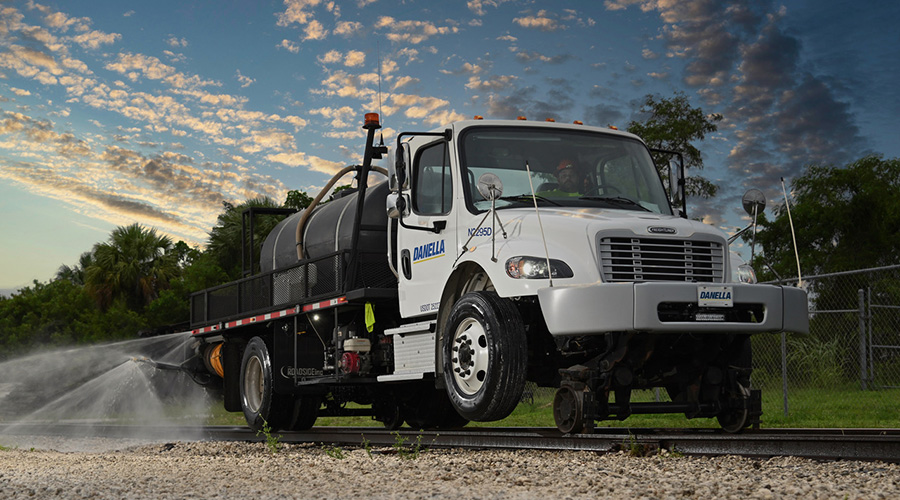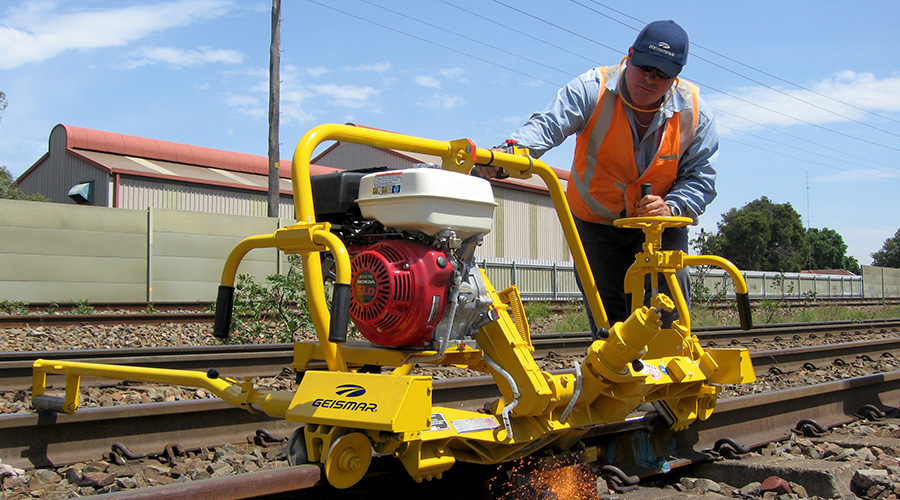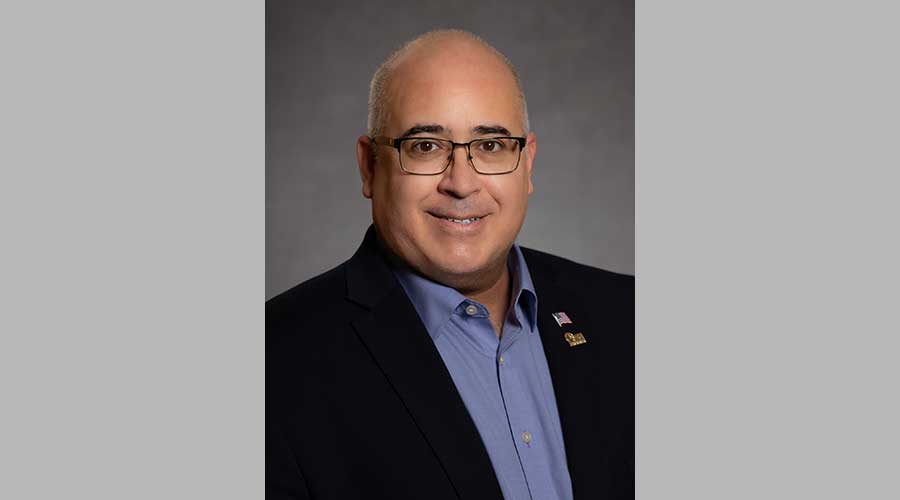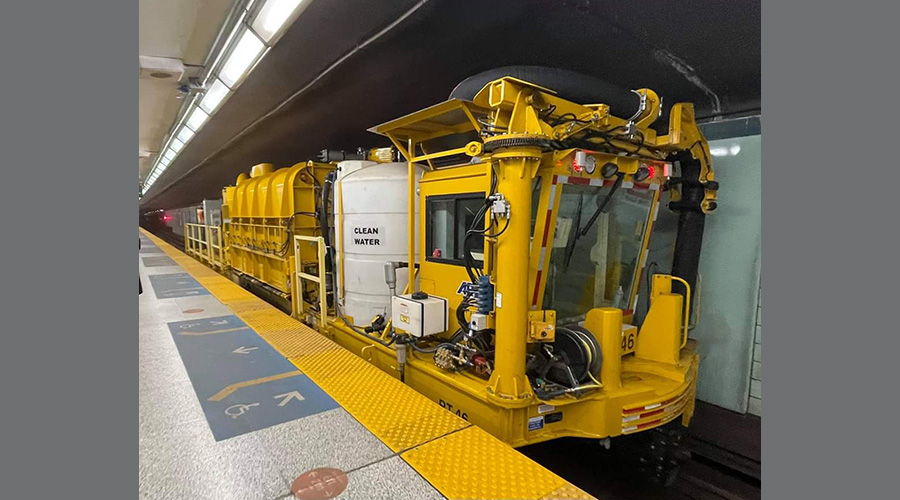Stay updated on news, articles and information for the rail industry
December 2007
Rail News: MOW
Six Contractors, Six Projects
Balfour Beatty Rail Inc.
Delta Railroad Construction Inc.
The Herzog Companies
R.J. Corman Railroad Construction L.L.C.
Railroad Construction Co. of South Jersey Inc./Railroad Construction Co. Inc.
RailWorks Track Systems Inc.
Delivering on the design-build promise
Balfour Beatty Rail leads the electrical charge on LA MTA’s massive Metro Gold Line extension
Signaling, traction power, communications and overhead catenary lines — they’ve all been designed and are being built for the Los Angeles County Metropolitan Transportation Authority (LA MTA) by a team led by Balfour Beatty, the world’s largest fixed-rail infrastructure contractor.
It’s actually Balfour Beatty’s U.S. subsidiary, Balfour Beatty Rail Inc. (BBRI) that’s leading the electrical charge on LA MTA’s Metro Gold Line Eastside Extension. BBRI is part of a joint venture (JV) with Los Angeles-based electrical contractor Steiny and Co. Inc. When completed in late 2009, the 6.2-mile, $898 million double-track light-rail extension will feature sophisticated electric, signaling and communications systems that also fit in with the Gold Line’s urban route, says Joe Reed, vice president of BBRI’s Western Region.
The project also includes adding eight station stops along a densely populated corridor extending into East Los Angeles. And it’s on schedule.
“We’re out there showing people that you can do the whole design-build concept successfully,” Reed says. “That’s one of the reasons why we won this contract.”
Prepared for change
Although the official groundbreaking was held in July 2004, BBRI kicked off the construction phase for electrical work in October 2007, says Jeff Rogers, BBRI senior project manager for the extension. That portion of the project is valued at more than $90 million.
BBRI, its JV partner and subcontractors have begun installing the poles for the catenary system, along with conduit systems for the train signaling and traction power systems — an effort that also features work in a two-mile tunnel. The design calls for a low-profile catenary system to power the trains, which LA MTA wanted for aesthetic reasons.
Power plans include a traction power design that features a system-wide Emergency Trip Station scheme, which enables traction power to shut off at the affected sections from wayside emergency trip stations, according to Burns Electrification Group, a project subcontractor. The line also will include remote control of the traction power system through a supervisory control and data acquisition (SCADA) remote control system.
“Technology changes relatively quickly, but we’re prepared to make changes where we need to,” Rogers says.
Project’s on track
BBRI began the construction effort employing a single 10-worker shift, but the total eventually will ramp up to as many as 35 during the anticipated mid-2008 peak, Rogers says. The construction work should be completed by September 2008, followed by three to four months of internal testing and several months of pre-revenue testing.
There’ll be challenges to face, particularly with the tunnel work, and with the widening and strengthening of the historic 1st Street Bridge over the Los Angeles River, which will accommodate rail and vehicular traffic. But BBRI’s prepared to meet those challenges, officials say.
And once the project is complete, Reed and Rogers hope that BBRI can continue to play a role in a possible second phase of the Gold Line Extension. LA MTA is considering adding another seven miles to the line. 
— By Robert J. Derocher
Lending a light-rail hand
Delta Railroad Construction put its experience to work in helping to launch Charlotte Area Transit System’s LYNX
When challenges arose during the construction of North Carolina’s first light-rail transit system, Delta Railroad Construction Inc. officials were confident they’d be able to meet them.
“We’ve done light rail projects in Houston, Little Rock, Memphis, Newark and Cleveland,” says Larry Laurello, president of Delta, the prime track installation contractor for the $427 million LYNX Blue Line in downtown Charlotte. “We know our way around.”
Despite some design delays and the challenge of installing rail from scratch in a busy urban environment, Delta put its know-how to work in helping the Charlotte Area Transit System (CATS) complete the 9.6-mile light-rail line, which opened Nov. 24.
Initially, the line — which runs between the city’s uptown and its southern border with South Carolina — will carry more than 9,000 passengers daily, CATS officials project.
‘A Lot in short order’
Delta’s contribution to the project included installing more than 18 miles of track with crossovers. The firm installed ballasted concrete ties and 115-pound welded rail, Laurello says. The contract value of Delta’s work? About $18 million,
Work began in 2005, and problems with bridge redesigns pushed much of the rail installation back to late 2006 and into 2007. Even so, CATS executives wanted a 2007 system opening.
“We had very little time. We had to build a lot of track in very short order,” Laurello says. “There were times when we were working seven days a week.”
Along with the time crunch, Delta also had to integrate the rail line with the city’s existing scenic trolley line, which is sharing trackage with the Blue Line.
“We had to remove the trolley system and reinstall the double track,” Laurello says.
Well-positioned, transit wise
And like similar projects in other urban areas, Delta and the other contractors faced the difficult task of moving equipment and material in and out of densely populated neighborhoods and commercial districts, while still sticking to a tight timeline.
Careful coordination with 15 to 20 contractors, combined with Delta’s use of high-tech equipment and a steady crew of up to 20 workers, were vital to completing the job on time, Laurello says.
“The first phase [of a new project] is always the hardest, but it was a pretty fun project,” Laurello says. “Things are in pretty good shape.”
The project’s phase includes extending the Blue Line 11 miles, in addition to constructing another 13.5-mile light-rail corridor.
The next-phase projects have yet to go out to bid.
“There are a lot of things going on [in transit], and we’re in a good position,” he says.
A bit of experience always helps, he adds. 
— By Robert J. Derocher
From Start-up to growth ramp-up
For the past decade, Herzog has helped Trinity Railway Express keep pace with growing ridership demand
When The Herzog Companies began working with Trinity Railway Express (TRE) a decade ago, the Dallas-Fort Worth area’s then-new commuter line used rented Amtrak equipment on 10 miles of track acquired from a bankrupt railroad to carry 175,000 riders a year between three stations.
Today, the 35-mile TRE carries more than 2 million riders annually along a 34-mile corridor with 10 station stops. And as the ridership growth continues, Herzog and its family of companies remain key partners in the operation, maintenance and construction of the still-expanding commuter line.
“We’ve had a lot of things happening, and it’s definitely going to be another busy year ahead,” says Bob Smith, vice president/operations of Herzog Transit Services Inc.
A cooperative service provided by the Fort Worth Transportation Authority (the T) and Dallas Area Rapid Transit (DART), TRE links downtown Fort Worth, downtown Dallas and DFW Airport on track that once belonged to the former Rock Island Railroad.
Herzog Transit Services, which has operated TRE since the railway’s December 1996 launch, also won a five-year contract in 2005 that includes maintenance-of-way and signaling work, and dispatching for both passenger and freight trains.
“There are two Class I railroads, two short lines and a commuter railroad operating there,” Smith says. “It’s a busy area, and it’s a challenge to coordinate everything, but our client is Trinity.”
All in the (Herzog) family
Also playing a role in TRE’s success is Herzog Contracting Inc. To accommodate TRE’s continued growth, several double-track projects to boost capacity and on-time performance have been — and will continue to be — the focus of Herzog’s construction work, says Derek Piwonka, area manager for maintenance and construction.
Earlier this year, Herzog installed five miles of double track that connects two sidings, and was installing two more double-tracked miles late last month. Other work in progress includes construction of a new bridge and station platform. More double-tracking — 2.6 miles worth — is on tap for 2008 as part of an $11.5 million contract. Other planned work includes connecting a major siding to a second mainline.
Meanwhile, Herzog continues to push ahead with a project that began in 2004 to bring “quiet zones” to the city of Irving. This year, Herzog installed three four-quadrant gates as part of the effort to make Irving train-whistle-free. Four more four-quad gates are on tap for ’08.
Rising TRE ridership, coupled with the surge in freight rail traffic on and around the TRE rail lines, makes project scheduling a challenge. So far, so good: Herzog dispatches about 50 commuter trains and 15 to 20 freight rail movements a day on the TRE, and “we’re proud to say that we have a 99.9 percent on-time rating for passenger rail,” Smith says.
TRE’s schedule also contributes to the challenge, often limiting major trackwork to Sundays and holidays, Piwonka says. That’s why representatives from the two Herzog companies meet regularly. Also, an updated maintenance and construction plan is published a week in advance to help train crews avoid traffic delays.
“All the different aspects of this require good communication, and that coordination comes pretty natural to us,” Piwonka says.
In the meantime, Herzog execs look forward to helping keep TRE on the growth track.
“There are a lot of federal dollars at work here, and the pipeline is still strong,” says Ray Lanman, vice president of corporate development for Herzog Transit Services. “We’re looking forward to more opportunities.” 
— By Robert J. Derocher
A Contractor With short-line sensibilities
R. J. Corman taps railroad operator experience to complete multi-faceted maintenance-of-way project for The Bay Line Railroad
When R.J. Corman Railroad Construction L.L.C. goes to work for a short-line railroad, the short line is getting a little bit more than a rail contractor — the railroad’s getting a contractor with inside knowledge of how a short line works and what its needs are, says Leeroy Davidson, president of R.J. Corman Railroad Construction.
The construction company is part of the R.J. Corman Railroad Group, which includes a division that operates nine short lines in five states — as well as divisions that include rail equipment sales and rental, derailment services and materials sales.
“We understand their operations. Not every contractor has worked around railroads and short lines the way we have,” Davidson says. “That’s certainly a big plus for us.”
It was that knowledge and experience that was a plus for The Bay Line Railroad L.L.C., which operates in Florida and Alabama, and is one of 47 short-line and regional railroads owned by Genesee & Wyoming Inc. (GWI)
As of press time, R.J. Corman was on track to have completed more than $2 million worth of work on two separate projects for The Bay Line.
‘You have to bend a little ...’
One project consisted of installing 15 miles of continuous-welded rail and 5,000 ties, as well as replacing 11 switches on the railroad’s mainline. At the same time, the firm also was regrading and repairing a mile of siding.
“They move a lot of cars down there, and they needed the extra space to store longer trains,” Davidson says.
At the project’s peak, R. J. Corman employed up to 65 workers on four different crews, which included surface rehabilitation workers, a rail gang, a switch building crew and crosstie cutters, Davidson says. Crews worked late-afternoons and nights, usually in eight-day shifts, with six days off to accommodate rail traffic.
“It was a big challenge just trying to keep people out of each other’s way,” Davidson says.
But, once again, Corman’s construction/short-line experience helped.
“Most railroads want you in and out of there, and that’s what we were able to do,” he says. “You have to bend a little to get yourself to work with traffic. We understand that the railroad’s operations still have to continue.”
A happy customer
For the Bay Line project, it also meant working with the railroad to get the materials needed for the job in the right place at the right time.
“[The Bay Line] was short-handed in unloading the material, so we helped them get it in the right place,” Davidson says.
Challenges? Sure. But none that R.J. Corman hadn’t faced before.
“It was a pretty common project for us — it’s something we do all the time,” Davidson says, adding that the key is having the manpower, experience and planning to get the work done quickly, efficiently and correctly. “We have the resources to handle it all and to do the right job.”
GWI/Bay Line officials think so, too.
“We are very pleased with the coordination in working with R.J. Corman,” says Rick Leggett, GWI vice president of engineering, Southern Region.
“The project is going better than we planned.” 
An Agent of change(outs)
Railroad Construction Co. of South Jersey/Railroad Construction Co. joint venture completes ‘wholesale changeout’ of switches and turnouts for PATCO’s rapid-transit line
The Port Authority Transit Corp. (PATCO) launched Speedline commuter-rail service between Philadelphia and southern New Jersey in 1969. PATCO’s made quite a few changes to the line during the past 39 years — from building stations to buying new rail cars to renaming the 13-station, 14.5-mile service the “High Speed Line.” More than 120 rail cars carry 38,000 passengers daily on the line. But PATCO had never changed out switches or turnouts — until recently.
As of press time, a joint venture comprising Railroad Construction Co. (RCC) of South Jersey Inc. and sister company Railroad Construction Co. Inc. was putting the finishing touches on an $18.6 million rehabilitation and reconstruction project that includes PATCO’s “first wholesale changeout,” says Tom Bergbauer, RCC of South Jersey project supervisor.
“There were some challenges for us and there was a lot of work for PATCO, but we think it has been successful,” he adds. “We’ve only heard good things about the quality of our work.”
The delay-free quest
Under the contract, which was awarded in 2005, RCC has been rehabbing and/or replacing 18 turnouts, four interlockings and one crossing diamond; resurfacing the entire track bed in both directions; and replacing all switch machines with more durable ones, and bolted rail joints with continuous-welded rail. More than 35,000 tons of new ballast was used during the rehab, Bergbauer says.
Weeknight crews comprising up to 12 workers and weekend crews of 20 to 25 completed the work while trains kept rolling through the construction area.
“On jobs like this, it’s important to the railroad to have full service running on Monday morning, after the work is done,” Bergbauer says. “We went through this whole job without having any delays in service on Monday mornings.”
Keeping service delay-free wasn’t easy. RCC was required to keep its equipment and materials at PATCO’s Lindenwold train yard at the line’s far eastern end, which added as much as two hours to each of the scheduled outages. The need to keep at least one track operating also presented equipment staging challenges.
“There were times when you would end up with 10 pieces of equipment on one track,” Bergbauer says.
On the noise-reduction track
That made communicating with railroad dispatchers and engineers all the more critical. It helped that RCC of South Jersey and PATCO had worked together on previous projects, Bergbauer says.
The contractors also kept the communication lines open with area residents. The rail line runs through residential neighborhoods, so “there was a lot of attention paid to make sure that the residents were warned in advance about the noise of the work,” Bergbauer says. “We did our best to minimize that.”
A recent conversation with a friend who lives near the line convinced Bergbauer that they were on the right noise-reduction track.
“He said that you could always hear the noise of the trains as they went through an interlocking, but now that the work is done, you can hardly hear it,” he says.
Sounds like success. 
— By Robert J. Derocher
Clearing Hurdles, contractor style
Despite inclement weather and tight work windows, RailWorks is on track to help SEPTA complete an ambitious $567 million reconstruction project
More than four years after the planning and site work began for the Southeastern Pennsylvania Transit Authority’s (SEPTA) Market Street Reconstruction project in Philadelphia, the end is finally in sight for rail contractor RailWorks Track Systems Inc.
“We’ve been out there in the rain and the sleet and the snow, and all kinds of weather to get the job done,” says Bill King, the New Jersey-based area manager overseeing the job for RailWorks. “We were the first contractor on the project, and we’ll be the last.”
In addition to inclement weather, workers have had to contend with tight work windows and balancing the needs of different contractors. Even so, RailWorks is on schedule to help SEPTA finish one of its most ambitious reconstruction projects by late 2008.
The $567 million reconstruction effort was launched in 2003 with the aim of rebuilding five rail stations and more than 16,000 linear feet of track on the transit system’s elevated portion. RailWorks was awarded two separate contracts worth $17.1 million. The $10.9 million Guideway project called for removing existing track and installing 12,000 linear feet of new direct fixation track and contact rail, as well as two double crossovers.
Executing the game plan
For the $6.2 million Cobbs Creek Completion project, RailWorks is installing 2,100 linear feet of direct fixation track and contact rail, and removing and renewing 2,200 linear feet of ballasted track and contact rail.
Complicating the process is a limited weekend construction window, which requires building temporary towers — as well as temporary fastening of six track bridges — until a section can be permanently completed.
“It’s a lengthy process to get a section done,” says Robert Munn, the RailWorks superintendent on the job. “It’s especially hard when you’re doing both tracks at once.”
RailWorks recently put the brakes on the Guideway project for the winter season with about 70 percent of the work done. The tough part is coming up this spring. That’s when work will be done on both the Guideway and Cobbs Creek segments simultaneously, King says.
During a planned nine-day system outage, RailWorks will demolish existing track and replace it with 648 feet of direct fixation track on the Cobbs Creek section, while doing the same with 1,350 track feet at Guideway. During a second outage — this time, it’ll be 16 days — 1,872 track feet will be similarly demolished and replaced at Guideway, while 1,180 feet of direct fixation track and 1,000 track feet of ballasted track will be demolished and replaced at Cobbs Creek.
“Carrying out this magnitude of work in so brief a period of time will require RailWorks to have a very well thought-out work plan and near flawless execution of that plan,” King says. “This task is made somewhat more difficult due to the fact [we] work for a different general contractor in each section.”
In addition to the extended outages, RailWorks will utilize planned weekend outages in much the same way it has so far, Munn says. Such challenges are nothing new for RailWorks, which worked in similar fashion on a SEPTA project on the Philadelphia’s east side.
Another project twist is its location: elevated track in a busy commercial and residential area.
“You’ve got people living and working there less than 30 feet away,” Munn says. “There’s a lot to work around.”
But the RailWorks team wouldn’t have it any other way.
“We’re not surprised when something comes up. We know how to handle it,” King says. “We’ve always completed what we’ve needed to be completed on time.” 
— By Robert J. Derocher


 LRW Honors Amtrak’s Acheson As Railway Woman Of The Year
LRW Honors Amtrak’s Acheson As Railway Woman Of The Year
 From Editor-In-Chief Foran: Of Gender Equity And Inclusion
From Editor-In-Chief Foran: Of Gender Equity And Inclusion
 Spotlight On Some Of Today’s Rail Safety Products
Spotlight On Some Of Today’s Rail Safety Products
 Women of Influence in Rail eBook
Women of Influence in Rail eBook
 railPrime
railPrime







